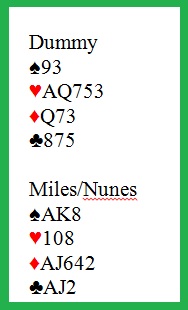leggi in italiano»
 The International Mind Sport Association (IMSA) organises every four years the World Games (WMSG), which comprises five sports: Chess, Chinese Chess (Xiangqi), Draught, Go and Bridge, and let’s hope the Backgammon would soon enter too between the others. The first edition of WMSG had been held in Beijing in 2008; now is the time of Europe, in the French town of Lille. The World Bridge Games consists of four series: Open, Women, Senior, and World Transnational Mixed Teams Championship (WTMTC; thereinafter Transnational Mixed Team). In the first three series it is allowed only a team per Nation, that is the USA have only one team instead of the usual two of the Bermuda Bowl; the Transnational Mixed Teams are utterly open to all players of all nations, only provided that all the pairs of the team are mixed (a man and a woman).
The International Mind Sport Association (IMSA) organises every four years the World Games (WMSG), which comprises five sports: Chess, Chinese Chess (Xiangqi), Draught, Go and Bridge, and let’s hope the Backgammon would soon enter too between the others. The first edition of WMSG had been held in Beijing in 2008; now is the time of Europe, in the French town of Lille. The World Bridge Games consists of four series: Open, Women, Senior, and World Transnational Mixed Teams Championship (WTMTC; thereinafter Transnational Mixed Team). In the first three series it is allowed only a team per Nation, that is the USA have only one team instead of the usual two of the Bermuda Bowl; the Transnational Mixed Teams are utterly open to all players of all nations, only provided that all the pairs of the team are mixed (a man and a woman).
In the Open event there were sixty teams divided in four round robin (RR), each match by sixteen deals. The best four of every RR got the knockout stage (round of 16, quarterfinals, semifinals, final, play off for the third place). These rules are the same for Seniores and Women.
In the Senior event there were thirty-four teams in two groups, so were qualified the best eight teams of both groups. The Italian Seniores (Giampiero Battistoni, Eugenio Bertolucci, Giampiero Bettinetti, Michele Ferrara, Leonardo Marino, Giuse Massaroli) got the fourth place in the RR; in the round of 16 they defeated Israel (147-111), but after they lost against France. In semifinals The Usa (Neil Chambers, Lew Finkel, Stephen Landen, Sam Lev, John Schermer, Richard Schwartz, Phillip Alder) and Hungary prevailed respectively over France (156-133) and Sweden (201-184). The Hungary won the final against the Usa (247-166) with these champions: Gyorgy Barany, Miklos Dumbovich, Mihaly Kovacs, Peter Magyar, Geza Szappanos, Gyorgy Barany, coach Beatrix Nagy. The France took the third place beating Sweden 224-149.
In the Women event there were forty-three teams in three groups, and were qualified the first five of each group and the best victory point scoring sixth one. The Italian women placed fifth, reaching the Round of 16 where they lost against a strong Netherland (129-184). It must be said that in the RR Italy has defeated all the first placed three teams: Sweden, Brazil and China. The championship of our women didn’t yield very much, here, but at least they showed the due gallantry: Caterina Ferlazzo, Gabriella Manara, Cristina Golin, Gabriella Olivieri, Annalisa Rosetta, Marilina Vanuzzi, Dano De Falco coach.
Then France (Catherine Vives, Carole Puillet, Rokia Poizat, Elisabeth Hugon, Sophie Dauvergne, Veronique Bessis) defeated Netherlands in quarterfinal, but, orphan of the great Catherine Saul D’Ovidio, had to bow before Poland (Cathy Baldysz, Ewa Banaszkiewicz, Katarzyna Dufrat, Danuta Kazmucha, Natalia Sakowska, Justyna Zmuda), which in turn was defeated by Russia (Svetlana Chubarova, Victoria Gromova, Anna Gulevich, Elena Khonichev, Tatiana Ponomareva, Olga Vorobeychikova). The European Queens – that is England – levelled all the others ending by a sound 209-140 over Russia: Sally Brock, Susan Stockdale, Fiona Brown, Heather Dhondy, Nevena Senior, Nicola Smith, Jeremy Dhondy (npc), David Burn coach.
The Transnational Mixed Team started after the RR stage of the other three events, so allowing to participate as more players as possible. It also had a RR and a KO stage, but the matches in RR were by 10 deals, not 16. The semifinals were reached by Canada (Judith and Nicholas Gartaganis, Daniel Korbel, Darren and Hazel Wolpert, Linda Wynston), who beat 110-69 in three segments China of Saic Red (Jianming Dai, Mao Yuan Hu, Yi Qian Liu, Liping and Wen Fei Wang, Zejun Zhuang, Longgen Cai), and Milner, winner by 77-66 over Yeh Bros (Dawei Chen, Japan; Jjuei-Yu Shih, Chen Yeh, Shu-Ping, Yeh Tong, Chinese Taipei; Kyoko Shimamura, Japan; Ping Wang, Yalan Zhang, China). In Final, Milner won against Canada 179,3 to 159 in five segments. These are the Champions of Transnational Mixed Teams: Petra Hamman, Hemant Lall, Reese Milner, Jacek Pszczola, Usa; Meike Wortel, Netherlands. And Gabriella Olivieri, Italia: brava Gabriella, tutti bravi!
In the Open event Italy (Bocchi, Madala, Sementa, Duboin, Versace, Zaleski) got an ease victory in her RR; then outscored Turkey, but in the quarterfinal her walk over stopped into the Polish wall made by Cezary Balicki, Krzysztof Buras, Grzegorz Narkiewicz, Piotr Zak, Jerzy Zaremba, Adam Zmudzinski, Piotr Walczak, Marek Wojcicki. Only one imps divided Italy from the victory, so she might had deserved it, but when it comes to speak of misfortune the only thing that has to be said is that we were an orphan team: we left at home one of the greatest living players, Lorenzo Lauria, and this is it.
The other team under the limelight, Monaco (Fulvio Fantoni, Claudio Nunes, Pierre Zimmermann, Franck Multon, Geir Helgemo, Thor Helness, Krzysztof Martens, Jean Charles Allavena), has stubbornly tried to be kicked off before the final. The first attempt has been against Canada: -15 at penultimate segment, +58 in the last one; failed it, they boldly tried again in quarterfinal against The Netherlands: -14 in penultimate, +45 in the last one. They didn’t discourage for so little: keeping the chin up, finally reached the goal against Sweden: -15 in penultimate, -24 in the last segment. So Sweden, an always strong nation but not much present in the last times, got the final where they scored off Poland: 342-188!
These are the Swedish Champions: Krister Ahlesved, Peter Bertheau, Per-Ola Cullin, Fredrik Nystrom, Jonas Petersson, Johan Upmark, Mats Axdorph, Jan Lagerman.
The hand: Discovery Playing
In Round of 16, match Canada-Monaco, Daniel Miles and Claudio Nunes were Declarers in this 3NT. Spade lead in both tables.
As usual, let’s start the playing plan by the count of the tricks: two spades, one hearth, one club. Thus it needs to make five tricks in diamonds, or four in diamonds and two in hearts, making finesse in the latter suit. Which suit has to be tried first? Miles played diamond ace at once catching the king, whereas Nunes choose hearth, the right way. As pointed out by the BBO’s commentator, the American champion Barnet Shenkin, this hand presented a problem of “Discovery Playing”, that is the way to play a suit depends upon how another suit lays, which therefore has to be tried first.
There are two way to play diamonds: if Declarer had to win all the five tricks, he would start by little to queen, hoping the king were doubleton onside. If, on the contrary, he could afford to give up a diamond – but not two – he would first draw the ace, in order to avoid that the queen would be taken by a stiff king offside: it is a common safety playing of the kind well depicted by Reese and Trezel. The diamond movement, therefore, depends upon the heart finesse, which has to be tried first, as correctly Nunes did.
***
Paolo Enrico Garrisi
August 23, 2012
